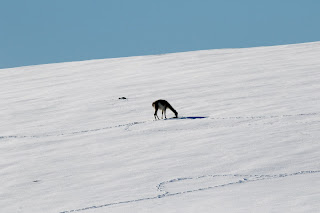From a birding standpoint I should have spent more time working around El Calafate, but I wanted to see more of Patagonia so I checked out of the Air B&B, loaded up the car and headed towards Rio Gallegos. There were plenty of guanacos along the highway as I passed the turnoff to the El Calafate airport and continued eastward on the famous AR 40. Argentinians are very proud of Ruta Argentina 40 which starts in the south at Punta Loyola near Rio Gallegos and goes north all the way to La Quiaca on the Bolivian border, a distance of 3227 miles across this huge country. If I remember correctly guanacos were the source of domesticated llamas and vicuna are the ancestors of alpacas. These camelids are well adapted to the dry patagonian steppe.
Another citizen of this arid scrubby grassland is the Lesser Rhea. I saw quite a few but I didn't get any great photos. These flightless ratites are much smaller than the Great Rhea which is commonly kept in zoos and native to the more lush northern grasslands.
Ruta 40 snaked it's way up the side of a plateau and suddenly I emerged onto a vast, snowy plain. I had seen this region from the plane a few days earlier but had no idea I would be driving through it.
As I drove through this icy wonderland I was shocked to see a small flock of shorebirds fly by. What the...? I doubled back and luckily found a couple. Yes they were shorebirds but not what you typically think of. These were Least Seedsnipes, one of the four herbivorous seedsnipe species of specialized shorebirds that occur though much of the Andes.
Descending from the plateau I found more Lesser Rheas,
I pulled off the highway for a lunch break and was fortunate to catch some critter scurrying though the grass. An armadillo? Yes it was the Patagonian Armadillo which apparently is the only member of this edentate family with the ability to store fat and hibernate through the winter. All other armadillo species occur though the neotropics and subtropics where they feed on insects year around. I guess this one had not long ago emerged for the spring.
After 180 plus miles I reached Rio Gallegos in the afternoon. (Spanish usually pronounces a "ll" as a "y". But in Argentina it is pronounced as a "sh" so they say Rio Gahshaygos. Spanish is a little different down there and at times I had a difficult time understanding with my poor Mexican spanish.) Anyway Rio Gallegos proved to be a dull, gray windy but friendly port town and much larger than I had anticipated with a population of over 100,000. With the help of Google Maps I found my way down to the waterfront and was soon glassing over the windy bay. Hooded Grebes have been found here in winter. Though my binocs I picked out what looked like several pale bodies with dark heads. Hooded Grebes? I fired a few shots and zoomed in on the back of the camera. No they were just very distant Imperial Cormorants. Ugh!
Another was much closer on this structure with Neotropic Cormorants.
Well it was cold and windy so I made my way to my Air B&B which was a bit more grim than I had expected. But it was in a good part of town and I was just a few blocks from restaurants. Problem was the nice ones had closed for the afternoon and would not reopen till 7PM which seemed to common down here. Eventually I found a food mall and got a mediocre hamburger. You would think in this land of cattle ranches that they would make good hamburgers but that was not my experience in the few that I consumed.



















No comments:
Post a Comment